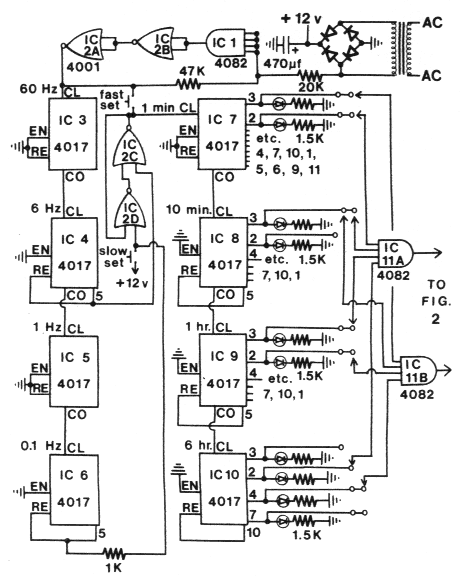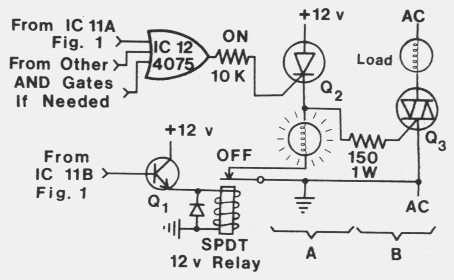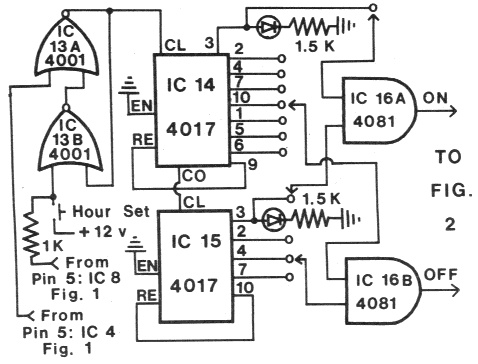Department of Entomological Sciences, University, of Califomia, Berkeley, California 94720
Present address:

 Abstract.
An electronic timer consisting of CMOS integrated
circuits is described that synchronously switches multiple
electrical devices on and off on either circadian or
noncircadian cycles. Precision is attained to within
1 min when used in the circadian mode or to within
16.7 msec when used at the highest speed (60 Hz).
The electronic timer is useful for behavioral studies,
control of environmental chambers, and control of
general laboratory appliances.
Abstract.
An electronic timer consisting of CMOS integrated
circuits is described that synchronously switches multiple
electrical devices on and off on either circadian or
noncircadian cycles. Precision is attained to within
1 min when used in the circadian mode or to within
16.7 msec when used at the highest speed (60 Hz).
The electronic timer is useful for behavioral studies,
control of environmental chambers, and control of
general laboratory appliances.


| Table 1. List of Components Used in the Electronic Timer (Figure 1), "On-Off" Switching Circuit (Figure 2), and Noncircadian Timer (Figure 3) | |||
| Figure 1 | Figure 2 | Figure 3 | |
|---|---|---|---|
| Resistors | |||
| 1 kohm | 1 | 1 | |
| 1.5 kohm | 26 | 2 | |
| 10 kohm | 1 | ||
| 20 kohm | 1 | ||
| 47 kohm | 1 | ||
| CMOS Integrated Circuits | |||
| CD4001 | 1 | 1 | |
| CD4017 | 8 | 2 | |
| CD4075 | 1 | ||
| CD4081 | 1* | ||
| CD4082 | 1+1* | ||
| Miscellaneous | |||
| SPST switch (NO) | 2 | 1 | |
| IN4001 diode | 4 | 1 | |
| Red LED | 26 | 2 | |
| 470-microfarad capacitor | 1 | ||
| 2N2222 transistor (Q1) | 1 | ||
| 12-V ac transformer | 1 | ||
| SCR 25-50 V (Q2) | 1 | ||
| Triac 200-400 V (Q3) | 1 | ||
| SPDT 12-V relay | 1 | ||
 Figure 3. Noncircadian photoperiod timer (32 h). Connection
of inputs of IC 16 to outputs of ICs 14 and IS determine the
photoperiod (20 h light/12 h dark, as shown). A 32-day timer
can be achieved by connecting the 1-kohm resistor of IC 13B to
Pin 10 of IC 10 from Figure 1. Timers of 2-100 h or days can be
achieved by utilizing all 10 outputs of each decade counter (see
text).
Figure 3. Noncircadian photoperiod timer (32 h). Connection
of inputs of IC 16 to outputs of ICs 14 and IS determine the
photoperiod (20 h light/12 h dark, as shown). A 32-day timer
can be achieved by connecting the 1-kohm resistor of IC 13B to
Pin 10 of IC 10 from Figure 1. Timers of 2-100 h or days can be
achieved by utilizing all 10 outputs of each decade counter (see
text).|
JOHN A. BYERS Department of Entomological Sciences, University, of Califomia, Berkeley, California 94720 Present address: 
|
|---|